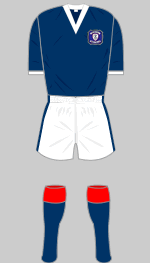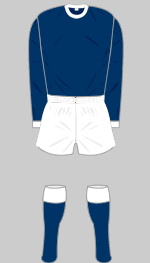Kit History
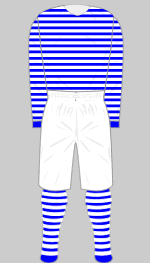
1876-1880 a l
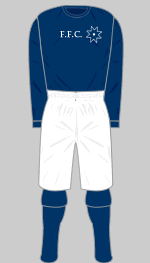
1880-1882 l w
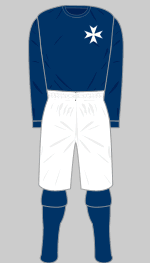
1884-Dec 1887 l w
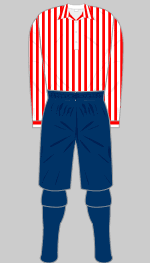
Jan 1888-1889 a l x
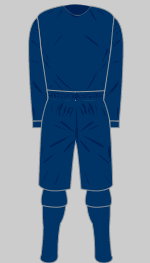
1889-1898 a l
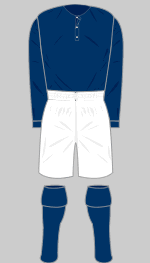
circa1900-1902 l
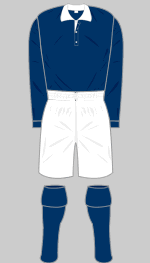
1902-1903 l
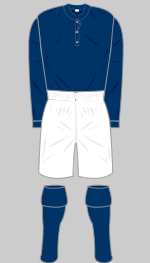
1904-1905 l
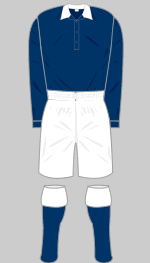
1906-1907 x
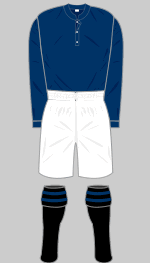
1907-1908 r
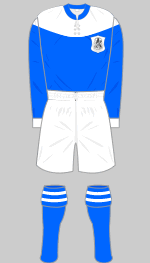
1909-1910 w x
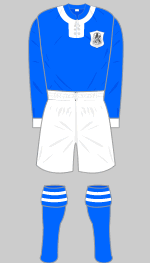
1910-1911 w
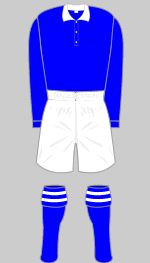
1912-1913 k l
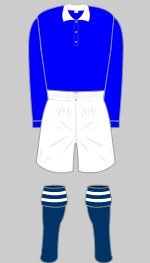
1913-1914 l s
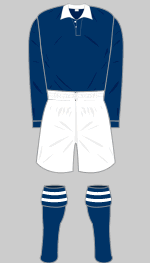
1915-1921 l x
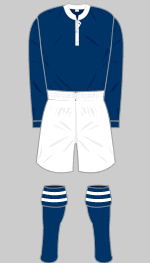
1921-1922 l
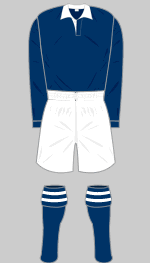
1922-1926 l
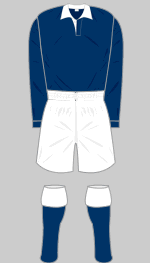
1926-1929 l
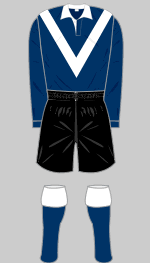
1927-1929 away l
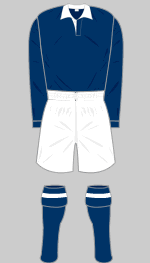
1929-1932 l
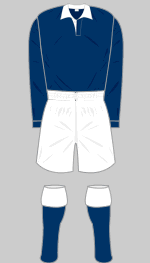
1932-1936 c l
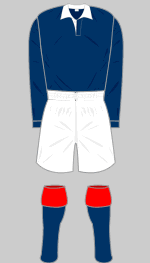
1936-1937 l
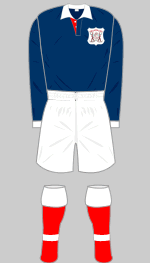
1937-1938 w A
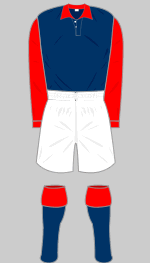
1938-1940 l y
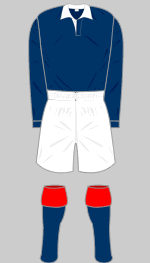
1945-1956 b l
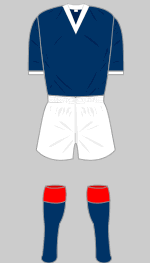
1956-1957 l
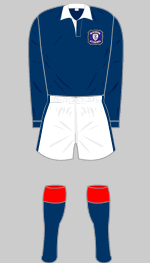
1958-1959 2 z
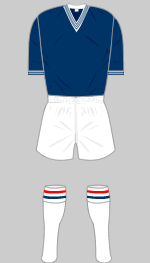
1959-1960 v
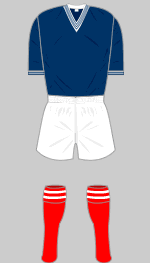
1960-1962 l
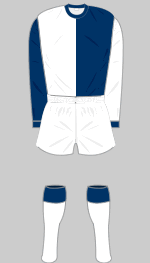
August 1962 k
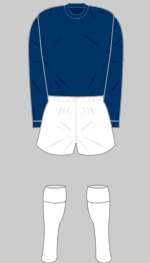
Nov 62-Feb 63 z
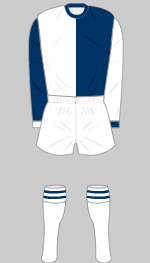
March-Aug 63 z
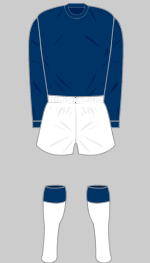
1963-1964 l z
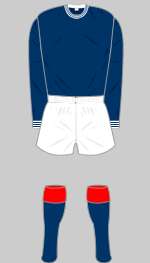
1964-1966 z
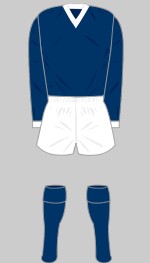
Aug-Nov 1966 z

Dec 1966 z
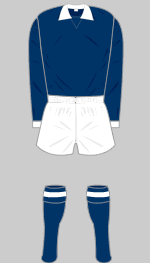
Mar 67-Dec 68 l z
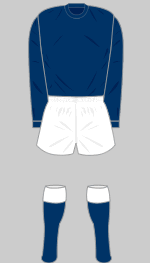
Jan-March 1969 z
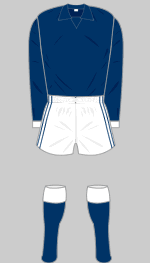
April 69-1970 l v
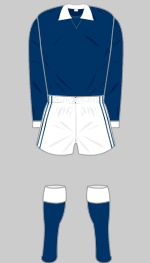
Aug 69 & Jan 70 z
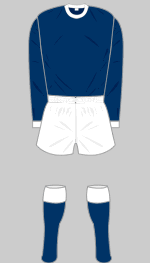
1970-1971 e l
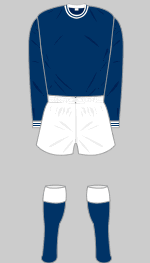
1971-1972 e l
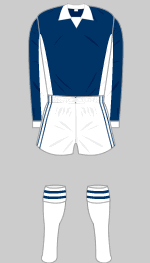
1972-1973 l
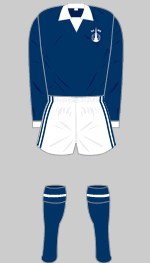
1973-1974 z
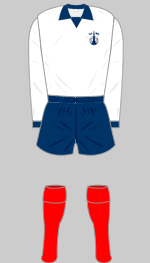
1974-1975 l
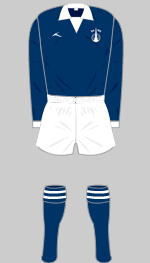
1976-1977 j z
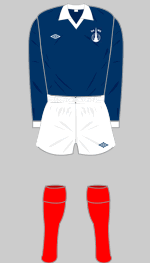
1977-1978 l
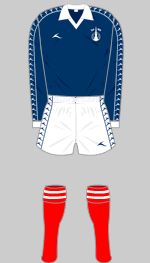
1978-1980 i k
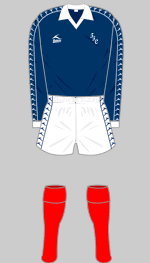
1980-1981 l
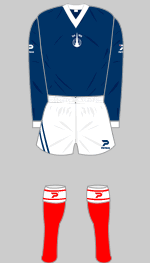
1981-1982 i l t
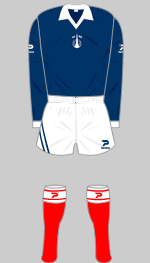
1982-Sept 83 j l m t
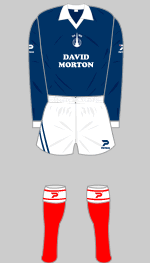
Sept 83-1984 l
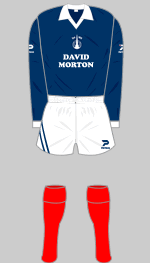
Aug - Dec 1984 l
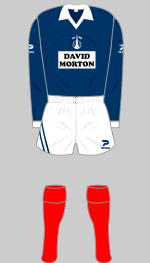
Dec 84-May 85 l
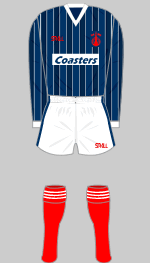
Aug- Nov 85 i l t z
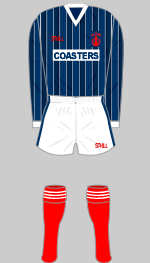
Nov 85-May 86 l z
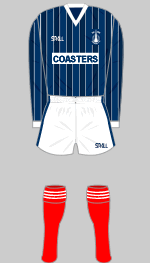
1986-1987 k l t
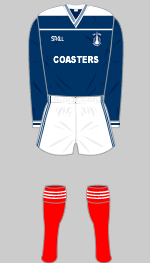
1987- Sept 1988 l
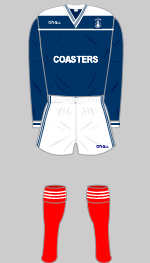
Sept 1988-1989 i
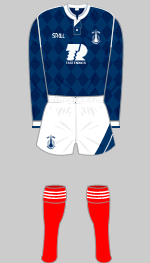
1989-1990 u
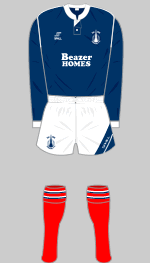
1990-1991 i
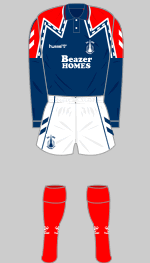
1991-1994 g i z
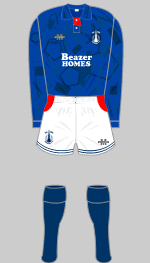
1994-1995 i
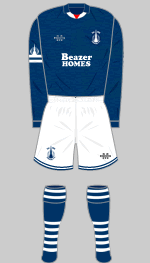
1995-1996 g z
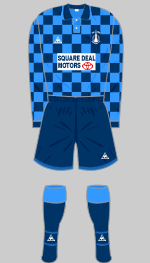
1996-1997 h o
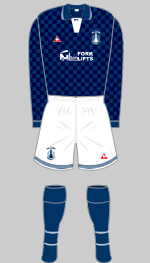
1997-1998 i
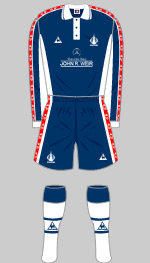
1998-1999 u
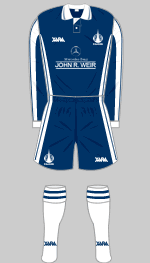
1999-2000 f
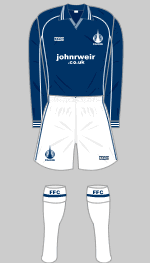
2001-2002 i
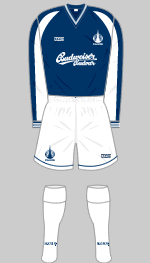
2002-2003 i
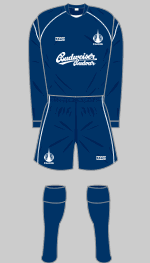
2003-2004 i
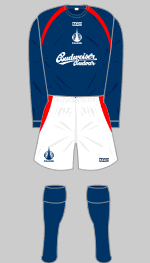
2004-2005 i
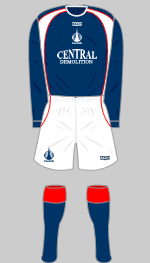
2005-2006 d i z
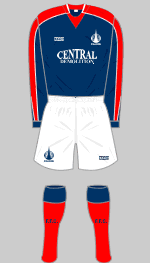
2006-2007 h i
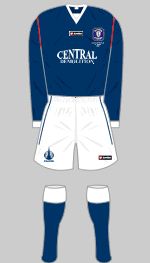
2007-2008 p q
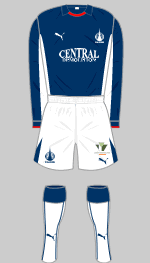
2008-2009 p q
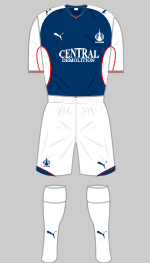
2009-2010 p z
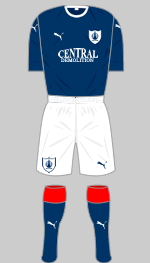
2010-2012 p q
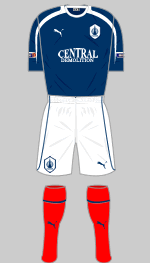
2012-2013 p
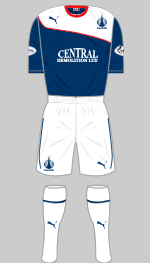
2013-2014 p
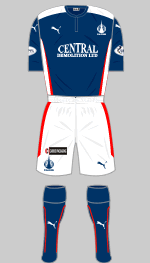
2014-2015 p z
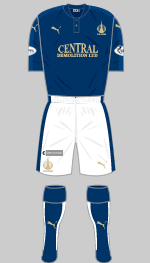
2015-2016 p
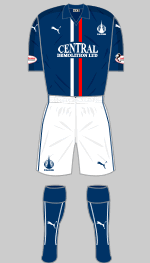
2016-2017 p
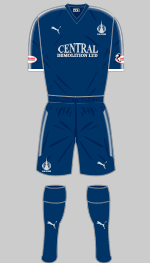
2017-2018 p
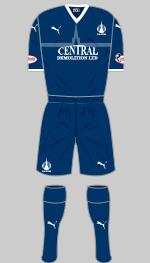
2018-2019 p
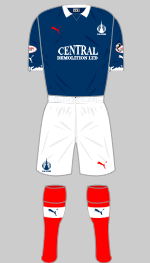
2019-2020 p
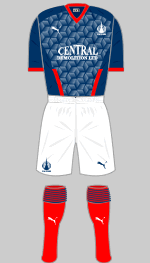
2020-2021 p
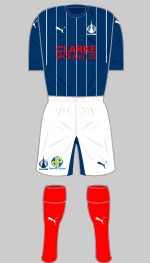
2021-2022 p
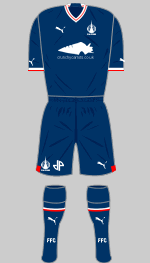
2022-2023 p
Background
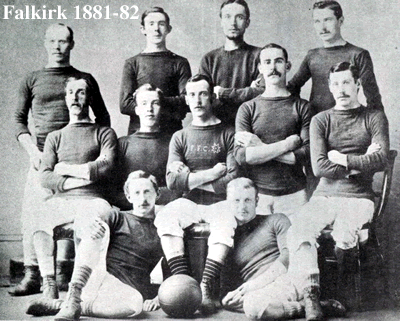 The origins of Falkirk FC
are uncertain although most accounts suggest 1876 was the year of their
formation. The club is nicknamed the “Bairns” from the town's motto (in Scots),
Touch Ane, Touch A' - Better meddle wi' the deil than the Bairns O' Falkirk.
The origins of Falkirk FC
are uncertain although most accounts suggest 1876 was the year of their
formation. The club is nicknamed the “Bairns” from the town's motto (in Scots),
Touch Ane, Touch A' - Better meddle wi' the deil than the Bairns O' Falkirk.
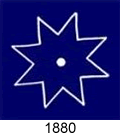 During the 1880s some intriguing detailing appeared on the team's otherwise plain navy jerseys. The first (1880) was worn by the captain alone while the second was worn by the entire team in a photograph from 1884-85. Andrew Hulett speculates on the better meddle... website that these are representations of the cross of St John, symbols that are associated with freemasonry. Although no corroborating evidence is available it is conceivable that some of the founders were members of the local lodge.
During the 1880s some intriguing detailing appeared on the team's otherwise plain navy jerseys. The first (1880) was worn by the captain alone while the second was worn by the entire team in a photograph from 1884-85. Andrew Hulett speculates on the better meddle... website that these are representations of the cross of St John, symbols that are associated with freemasonry. Although no corroborating evidence is available it is conceivable that some of the founders were members of the local lodge.
In December 1887 the committee decided on a change of colours and it appears the new scarlet and white 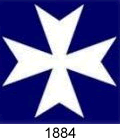 tops were to be worn in a northern tour against Coupar-Angus and Fair City Athletic. The first confirmation of the new colours comes in a press report of a match with Laurieston when it was noted that "Falkirk looked well in their new colours last Saturday, and appeared to be a much heavier team when dressed in shirts than when they had jerseys." They were last worn against Bo'ness in March 1889 after which navy jerseys were restored.
tops were to be worn in a northern tour against Coupar-Angus and Fair City Athletic. The first confirmation of the new colours comes in a press report of a match with Laurieston when it was noted that "Falkirk looked well in their new colours last Saturday, and appeared to be a much heavier team when dressed in shirts than when they had jerseys." They were last worn against Bo'ness in March 1889 after which navy jerseys were restored.
In 1902 the Scottish First Division was expanded from 10 to 12 clubs. Falkirk and Raith Rovers were elected to fill the vacancies created in the Second Division. The Bairns thrived and in 1905, having finished as runners up, were elected into Division One. In 1908 and 1910 they finished in second place.
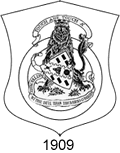 In 1909 a lighter blue replaced Falkirk's traditional navy and a crest appeared. Although the details are difficult to determine it seems this was based on the arms of the burgh, which had been adopted three years earlier.
In 1909 a lighter blue replaced Falkirk's traditional navy and a crest appeared. Although the details are difficult to determine it seems this was based on the arms of the burgh, which had been adopted three years earlier.
The club’s fortunes declined after the
outbreak of the First World War and they finished in the lower half
of the table regularly until 1935, when they were relegated. The following
season they won the Second Division title and finished near the top
of the table until 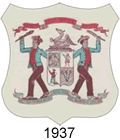 competition was suspended in 1939.
competition was suspended in 1939.
Another crest appeared in 1937, a quartered shield surmounted by a phoenix (symbol of the Carron Iron Company, the foundation of Falkirk's prosperity in the mid-19th century) and supported by two schoolboys (bairns) wielding clubs with the town motto (in Latin and Scots) on scrolls. These arms were never officially adopted but do appear on the Burgh Building, which dates from 1879.
The following season the crest disappeared and the team wore a new strip, which was described in a report by the Falkirk Herald (17 Sept 1938). "The new Falkirk rig-out was quite effective and was most favourably commented on by the crowd. The red sleeves and collars harmonised nicely with the familiar dark-blue and certainly made it easier for the players to find their man."
In 1946, Falkirk were placed in Division A (first
tier) where they held their own until being relegated in 1951. Once
again they bounced back immediately and went on to win the Scottish Cup in 1957, despite a mediocre performance in the league. In the final the team wore a specially designed crest that featured an armed highlander 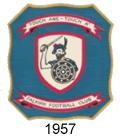 (a reference to the Battle of Falkirk in 1746) and part of the town motto, Touch Ane, Touch A' . The Highlander crest was worn in the following seasons and revived in 2007-08 to mark the 50th anniversary of the team's Scottish Cup win.
(a reference to the Battle of Falkirk in 1746) and part of the town motto, Touch Ane, Touch A' . The Highlander crest was worn in the following seasons and revived in 2007-08 to mark the 50th anniversary of the team's Scottish Cup win.
In 1959 they dropped back into Division Two, were promoted again in 1961. In August 1962, Falkirk appeared in halved shirts briefly: a 1-9 hammering by Motherwell may be the reason these were quickly replaced by traditional plain tops.
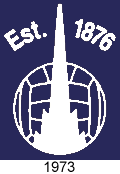 Falkirk went back down in 1969 and returned immediately as Division
Two champions in 1970. History repeated itself 1974-1975; relegation
followed by immediate promotion but this time, due to the reorganisation
precipitated by the introduction of the Premier Division, Falkirk found
themselves still in the second tier.
Falkirk went back down in 1969 and returned immediately as Division
Two champions in 1970. History repeated itself 1974-1975; relegation
followed by immediate promotion but this time, due to the reorganisation
precipitated by the introduction of the Premier Division, Falkirk found
themselves still in the second tier.
It is thought that the modern club crest was designed by the club secretary, Willie McFarlane using a sixpence as a template to draw the outline of the football. The design incorporates the Falkirk Steeple, an important local landmark.
The Bairns dropped into Scottish Division Two
(third level) in 1977 but won the championship in 1980 to return to
the second level and in 1986 they were promoted to the Premier Division,
which was briefly expanded to 12 clubs. In 1988 Falkirk finished 10th
out of 12 and were 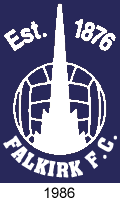 unfortunate to find themselves relegated when it
was decided to return to a ten club Premier Division. The following
season they finished as runners up but promotion and relegation now
involved only the top and bottom clubs.
unfortunate to find themselves relegated when it
was decided to return to a ten club Premier Division. The following
season they finished as runners up but promotion and relegation now
involved only the top and bottom clubs.
In the early 1990s Falkirk went up and down between the top divisions and spent the latter part of the decade challenging for, but never quite achieving promotion (now restricted once more to one-up and one-down).
In 1986 the crest was updated slightly with the addition of the club's name. There was another minor alteration 12 years later but the iconic football and steeple motif remaned untouched.
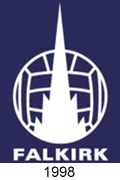 For the 1996-97 season, tradition was abandoned briefly for an extravagant checkered kit: the Bairns reached the Scottish FA Cup Final in that season, mercifully reverting to plain navy shirts for that match.
For the 1996-97 season, tradition was abandoned briefly for an extravagant checkered kit: the Bairns reached the Scottish FA Cup Final in that season, mercifully reverting to plain navy shirts for that match.
In 2000 the SPL was expanded from 10 to 12 clubs and Falkirk qualified for a three-way play-off to decide the remaining promotion place. Since their ground did not meet SPL standards (which at the time required a minimum all-seated capacity of 10,000) they were denied the chance of promotion and Dunfermline Athletic were promoted instead. Play-offs were abandoned the following season.
In 2002 The Bairns finished in ninth place in Scottish Division One (the second tier) and would have been relegated had Airdrieonians not gone out of business. The following season the club won the First Division and, in order to meet SPL requirements, they proposed to move into the New Broomfield stadium in Airdrie (a brand new stadium, then home to Airdrie United, the cost of which had bankrupted the original Airdrieonians club). The SPL refused to accept this idea and once again Falkirk were denied promotion.
In 2003 Falkirk left the run down Brockville Park (their home since 1885) to share Stenhousemuir’s ground on while a new stadium was built that met the stringent SPL requirements. The following season the SPL reduced the stadium seating requirement from 10,000 to 6,000 and in July 2004 the club opened their brand new Falkirk Stadium (capacity 8,750) on the outskirts of the town.
In April 2005, Falkirk clinched the First Division title and were finally readmitted to Scotland’s elite but dropped back into the second tier in 2010. A disastrous 2018-19 season brought relegation to League One (third tier) on the final day. When the 2019-20 season was ended early, Falkirk were just one point behind leaders Raith Rovers and remained there when points per game were calculated (1.86 compared to Raith's 1.89). There were no play-offs so Falkirk missed out on promotion.
Sources
- (a) Brian McColl
- (b) Dundee FC - Images of Sport (Paul Lunney 2001)
- (c) London Hearts
- (d) Red Card Scotland
- (e) Science & Society Picture Library
- (f) Angelfire
- (g) Classic Football Shirts
- (h) thebairninholland
- (i) SNSpix
- (j) Classic Kits
- (k) Ralph Pomeroy
- (l) Alick Milne (Research Associate)
- (m) St Johnstone FC - Images of Sport (Alastair Blair 2003)
- (o) Ranald Henderson
- (p) Falkirk Official Site
- (q) Travelling Bairn Site - A terrific site by Megan Sneddon (a regular contributor since the age of 11)
- (r) Neil Morris
- (s) John Small
- (t) Donald Gellatly (HFK Research Associate)
- (u) Graeme Mason
- (v) Keith Ellis (Research Associate)
- (w) better meddle...
- (x) Falkirk Football History
- (y) Falkirk Herald (19 09 1938) submitted by Alick Milne.
- (z) Ian McConnel
- (A) Football Cartophilic Info Exchange
Details of early crests courtesy of better meddle... Crests are the property of Falkirk FC.


